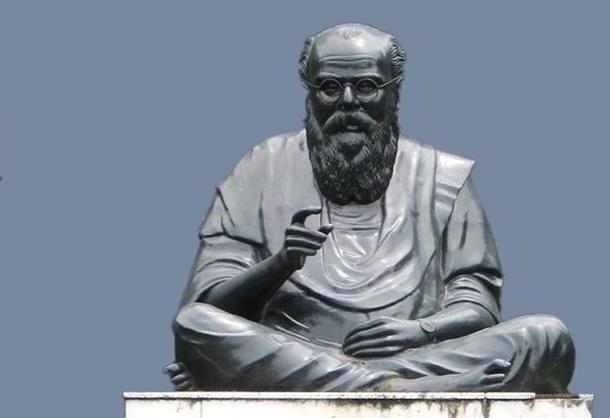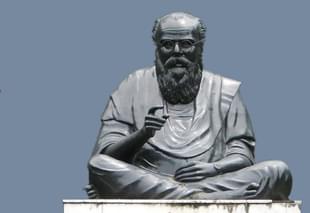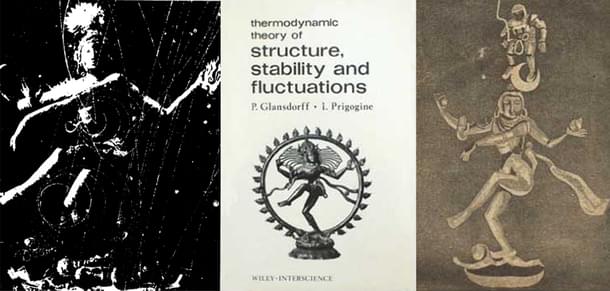Ideas
The Psychological Damage Periyar’s Pseudo-Rationalism Did To Tamil Nadu
Aravindan Neelakandan
Jan 25, 2020, 06:19 PM | Updated 06:19 PM IST
Save & read from anywhere!
Bookmark stories for easy access on any device or the Swarajya app.


In Inherit the Wind – a 1960 movie that dramatised the famous ‘Scope’s Monkey Trial’ of 1920s, there is a memorable scene. The trial had ended as a triumph of reason over religion. The secular humanist lawyer Henry Drummond (played by Spencer Tracy) as he leaves the court takes the Origin of Species in one hand and the Bible in the other. He weighs them both and then carries them both and then walks out.

In the West, Rationalism started with a strong clash with the religious structures which controlled thought and society. However they also looked for a compromise with those very structures.
They understood that these structures, even if they ultimately rested on irrationality, and had benefited from slavery and colonialism like the rest of the Western social structures, are necessary for the overall wellbeing of society. So, the rationalist movement always has been seeking some kind of a meeting point.
One of the greatest philosophers of reason in the Western tradition was Baruch Spinoza. He was also a monist. His worldview resonates with the Advaitic schools nurtured in India centuries before him. And centuries after Spinoza, many scientists when asked about their own spirituality would refer to the ‘God of Spinoza’. In all this, the rationalist movement sought not to demolish religion but transform it.
In this, they take their mythologies like the creation in Genesis and transform it into poetry and symbolism. There could have been massive localised floods which could have triggered the legend of a global flood, but global flood itself has become symbolic.
And the ark is more symbolic of the preservation of biodiversity rather than a historical artefact, unless you believe in pseudo-archaeological hoax claims on Mount Ararat.
In 2002, Rev Richard Harries, then Bishop of Oxford, and Richard Dawkins had signed a letter to the Prime Minister of England in which they stated that while evolution being a scientific theory has ‘a great explanatory power’ ‘the biblical account of creation … has a different function and purpose.’
Thus, though confrontational in its original context, rationalism historically and culturally strives to transform the history-centered literalist religion the West is burdened with, into a symbolic and poetic religion.
That brings us to the use of the term ‘rationalism’ and rationalist in Tamil Nadu in particular and Indian political parlance in general. In Tamil Nadu today, the term ‘rationalist’ is used or rather abused so loosely to mean anything that is anti-Hindu.
More rabid the anti-Hindu position, more the person gets hailed as a ‘rationalist’.
The trend is well exhibited in calling Erode Venkatappa Ramasamy (EVR) as a ‘rationalist’. And in the case of EVR, even his ‘rationalism’ was not original. Historian Antony R.H.Copley found his claims to originality of thoughts ‘silly and shallow’. This is the impression EVR made on Copley:
I had built up great expectations at the meeting with Naicker. Squatting on his bed — a kind of cross between Monses and Tolstoy. A tube to ease his kidney ailments. He addressed himself to Veeramani (?) his secretary. Once or Twice he took off his spectacles and peered at me. I could make no contacts with those vague eyes. I found him shifty. But he responded to flattery and I think I lost faith in Naicker when it was particularly insisted on that his ideas were his own. Only afterwards, he claimed, did he find his rationalism confirmed by other writers. I found this claim for originality silly and shallow. The endless attack on Brahmins become tiresome and vulgar, however valid.
Let us take his third-rate attack on Puranas for example, which are passed on as ‘rationalism.’
Hindu Dharma has a well-defined approach to Puranas. For example, Thirumoolar, in his Thirumantiram, points out that the Puranic act of Siva destroying the three worlds is actually an ever-recurring inner event of destruction of the three inner pollutants. Similarly, there are many aspects of Hindu Puranas and Hindu symbolism which Hindus know should be understood as subtle poetry and deep symbolism.
But EVR ignores this traditional approach. Instead, he always took a literal meaning and then demeaned the Puranas as superstition. So here we see the paradox. In the West, where rationalism arose, the rationalist movement seeks to transform religion from a literalist interpretation to symbolism and poetry, In India, the pseudo-rationalist movement personified in EVR tries to reduce the symbolism and poetry in the sacred literature into literal interpretation.
This is well exemplified in the famous iconography of Nataraja — the dancing Siva. The traditional interpretation of the Dance was popularised by Dr. Ananada Commaraswamy who wrote his now famous essay in the scholarly Saiva Siddhanta magazine Siddhanta Deepika. It soon became very popular with some of the best minds of science and art.
Nobel Laureate Illya Prigogine saw in the dance of Siva a symbolism that explains the dual nature of irreversibility so fundamental to thermodynamics. In his 1986 Darwin lecture on the Origins of Complexity, he stated:
...irreversibility generally has a dual aspect; it corresponds to dissipation (here the heat flow) and to the formation of order (the thermal diffusion). That is why I have put on the cover of one of my books a representation of a well-known Indian symbol, the dancing Shiva, who holds in one hand a fire which destroys, and in another a drum which creates!
Similarly, Fritjof Capra, a particle physicist who became famous through his best-selling book Tao of Physics in the preface to the book explains a life-changing experience he had:
I was sitting by the ocean one late summer afternoon, watching the waves rolling in and feeling the rhythm of my breathing, when I suddenly became aware of my whole environment as being engaged in a gigantic cosmic dance. Being a physicist, I knew that the sand, rocks, water and air around me were made of vibrating molecules and atoms, and that these consisted of particles which interacted with one another by creating and destroying other particles. I knew also that the Earth’s atmosphere was continually bombarded by showers of ‘cosmic rays’, particles of high energy undergoing multiple collisions as they penetrated the air. All this was familiar to me from my research in high-energy physics, but until that moment I had only experienced it through graphs, diagrams and mathematical theories. As I sat on that beach, my former experiences came to life; I ‘saw’ cascades of energy coming down from outer space, in which particles were created and destroyed in rhythmic pulses; I ‘saw’ the atoms of the elements and those of my body participating in this cosmic dance of energy; I felt its rhythm and I ‘heard’ its sound, and at that moment I knew that this was the Dance of Shiva, the Lord of Dancers worshipped by the Hindus.The Tao of Physics, Preface
In other words, Tamil Nadu has given to the world an unparalleled phenomenon in spiritual iconography which expands and deepens itself with the progress of science. It is a pride any civilisation would boast of. But what did the ‘rationalism’ of EVR do? They wanted to show the people that the dance of Siva was nothing but a Brahminical superstition.
Towards this end, they took the symbolism literally, which no Hindu — not even the most orthodox ones — do. They depicted an American astronaut descending on the crescent moon, which Siva wears.
Every devotee of Siva knows that the moon He wears is symbolic at multiple levels, which Indologist Stella Kramrisch explains thus:
On his head Siva carries the crescent moon, symbol of the renewal of vegetative life, of recurrent time, and the abode of the dead. ... Eternal and immovable, it governs and stands above the alternating succession of the white and black fortnights, a symbol of consciousness that contains the ideas of all that will be.’‘The Presence of Siva’, p.38 & p.151
What is true of the symbolism of Siva is also true of every Divinity the EVR ridiculed — with the worldview of a third-rate colonial missionary.
If anything, his ‘rationalism’ made most Hindus detest the word ‘rationalism’. Had he instead used the symbolism positively and constructively, then actually, he could have contributed to the growth of real passion for science.
After all, did not Einstein speak of the cosmic religious feeling as the womb of all good science and art? And, does not in the Dancing Siva, we have a powerful symbol to infuse us with it?
Because of EVR, all Tamil Nadu got was the feeling of being delinked with this great civilisational gift our ancestors bequeathed upon us — ultimately allowing idol thieves to rob us even physically of these treasures.
That may be the reason why we have not produced a Capra or a Prigogine or a Carl Sagan who could feel the dance of Siva in her own domain of knowledge though we have Him enshrined in our temples.
If confronted with this then, the ‘rationalists’ of the EVR variety would fast change the track. They will claim they bring in ‘social justice’. Further demeaning their own rationality, they say that their attack on Puranas or any Hindu literature is not because of their rational quest at all but because they seek ‘social justice’. Is not Hinduism and all its Puranas merely Brahminical plots to subjugate the non-Brahmins, particularly Sudras and Dalits?
Even the Ramayana EVR loves to hate, clearly espouses ideals and values that are egalitarian. Rama embracing Guha and his encounter with Sabari, the tribal woman, embody positive social values.
His enemy Ravana had a Brahmin father. His humbling of Parasurama shows that keeping grudges over past misdeeds should be given up lest it poisons one deeply. In Valmiki Ramayana, Rama even points to Parasurama being related to none other than Kshatriya turned Brahmarishi Viswamitra — a reminder to all ethnic purists that their claim to birth-based purity is just a myth.
But EVR would not use any of these aspects but would only project it as a text of a fight between two races — Aryan and Dravidian.
Bhagavat Gita may contain clear statements that shift the focus from birth-based concept of Dharma to individual nature-based individual Dharma. It may also contain strict statements that anyone who considers oneself superior to another because of birth or even because he could perform grand sacrifices, is actually demonic.
Such verses of the Gita may become strong weapons in the hands of anyone fighting against birth-based caste discriminations, which are a blot on our society.
But EVR or any of the black shirts he memetically bred would not use it. They would love to carry on the propaganda that Gita is nothing but imposition of hierarchical birth-based Varna system.
Maha Bhakta Vijayam could have inspired the greatest social reform warrior saint of Tamil Nadu — Swami Sahajananda. But Swami Sahajananda would not be appreciated. It would be EVR who practically did nothing but only peddled hatred and cheap thrills of obscenity from stage to stage in Tamil Nadu who would be hailed as ‘rationalist’ and ‘social reformer’.
Nothing should shame a real rationalist than calling EVR a rationalist. Nothing should shame a real social reformer than calling EVR a social reformer.
Aravindan is a contributing editor at Swarajya.





